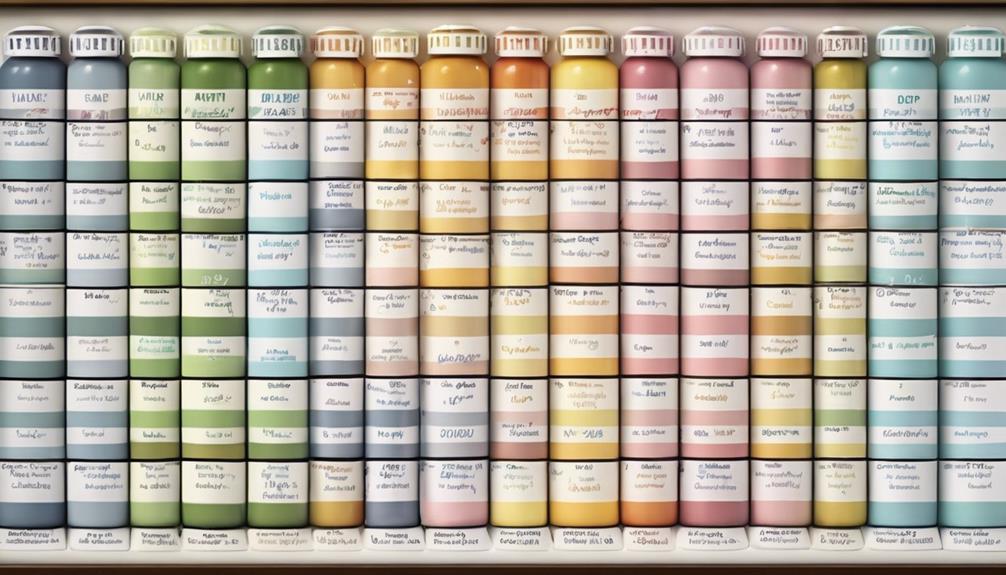When establishing a feeding routine for a 2-month-old baby who is being fed using formula, it can be compared to navigating through a symphony, where each feeding session plays a crucial role in creating a harmonious melody of nourishment.
The meticulous orchestration of ounces, timings, and baby's signals forms the foundation of this crucial routine.
However, what if we told you there's a key aspect many overlook, a secret ingredient that could transform the feeding experience for both baby and caregiver?
Let's uncover this hidden gem that promises to revolutionize your feeding schedule with formula for your 2-month-old.
Key Takeaways
- Offer 4-6 ounces per feeding for a balanced intake.
- Monitor weight gain and diaper output for nutritional adequacy.
- Adjust feeding frequency to meet changing needs.
- Establish consistent feeding times for routine and predictability.
Importance of Establishing a Feeding Routine
Establishing a feeding routine for your 2-month-old is important for fostering a sense of security and supporting the best growth and development. At two months, babies are starting to develop more predictable patterns, making it an ideal time to introduce a feeding schedule. By setting regular feeding times, you can help regulate your baby's hunger cues, ensuring they receive the nourishment they need without overfeeding or underfeeding. With formula feeding, having a structured feeding routine allows parents to plan their day more effectively, providing a sense of predictability for both the child and caregivers.
Tracking your baby's intake becomes more manageable with a consistent feeding schedule, as you can monitor how many ounces they consume at each feeding. This method also helps in ensuring that your child is receiving adequate nutrition throughout the day. Additionally, establishing a feeding routine enables parents to coordinate other daily activities around the baby's feeding times, promoting a smoother and more organized daily routine for the whole family.
Factors to Consider for Feeding Schedule

When planning a feeding schedule for a 2-month-old, it's important to take into account the baby's weight and age to determine the appropriate amount of formula to feed per pound daily. Here are some key factors to think about for creating an effective feeding schedule:
- Hunger Cues: Pay close attention to the baby's hunger cues and adjust feedings accordingly. Responding promptly to their signals can help establish a healthy feeding routine.
- Flexibility: Be open to adjusting the feeding schedule based on the baby's individual needs. Flexibility is important to accommodate their changing appetite and growth spurts.
- Monitoring Weight Gain and Wet Diapers: Regularly monitor the baby's weight gain and the number of wet diapers to make sure they're getting enough formula. These indicators can help gauge if the current feeding schedule is meeting the baby's nutritional requirements.
Creating a Balanced Feeding Routine
After considering the factors for a feeding schedule, let's now focus on ensuring a balanced feeding routine for a 2-month-old. Formula-fed 2-month-old babies typically require 4-6 ounces of formula per feeding every 2-3 hours during the day. To maintain a balanced routine, babies should ideally consume around 2½ ounces of formula per pound of body weight daily to support healthy growth patterns. It is essential to monitor weight gain and the number of wet diapers to make sure the baby is getting adequate nutrition. Adjusting feeding amounts and frequency based on the baby's cues and growth patterns is essential for maintaining a balanced feeding schedule that caters to their individual needs.
| Feeding Schedule Guidelines |
|---|
| Feed every 2-3 hours |
| Offer 4-6 ounces per feed |
| Monitor weight gain and wet diapers for adequacy |
Tips for Feeding a 2-Month-Old

In caring for a 2-month-old, guaranteeing a proper feeding routine is essential for their growth and development.
When feeding a 2-month-old formula-fed baby, consider the following tips:
- Ounces per Feeding: A 2-month-old typically consumes 4-6 ounces per feeding to meet their nutritional needs. Adjust this amount based on the baby's weight, aiming for around 2.5 ounces per pound daily.
- Monitoring Signs of Nutrition: Look for indicators like weight gain and wet diapers to guarantee your baby is getting adequate nutrition. These signs can help you assess if the feeding amount is appropriate for their growth.
- Feeding Frequency and Consistency: Adjust the feeding frequency as your baby grows and becomes more efficient at feeding. Establish consistent feeding times to create a routine and monitor hunger cues for timely feedings, ensuring your baby's nutritional needs are met effectively.
Adjusting the Schedule as Baby Grows
To guarantee optimal growth and development, adjusting the feeding schedule as the baby grows is essential for meeting their evolving nutritional needs. As a 2-month-old baby on a formula feeding regimen, it is vital to monitor weight gain and diaper output regularly. These indicators help determine if adjustments to the feeding schedule are necessary. Being flexible with nighttime feedings is also important, as babies' appetites and growth spurts can vary. Parental observation plays a key role in ensuring the baby appears satisfied and content after feedings, indicating that the current schedule is meeting their needs.
| Key Points | Importance |
|---|---|
| Monitoring Weight Gain | Ensures baby is growing adequately |
| Diaper Output | Reflects how well the baby is digesting the formula |
| Nighttime Feedings | Flexibility required for adapting to baby's needs |
Regularly evaluating these factors and staying flexible with the 2-month-old baby feeding schedule will contribute to a successful routine that supports the baby's health and development.
Frequently Asked Questions
What Is the Ideal Feeding Schedule for a 2 Month Old Baby?
We find that the ideal feeding schedule for a 2-month-old baby typically involves feedings every 3-4 hours throughout the day. Adjusting based on hunger cues is essential. Monitoring weight gain, diapers, and satisfaction helps determine effectiveness.
How Do I Set a 2 Month Old on a Schedule?
We establish a 2-month-old's routine through attentive observation and adaptive feeding schedules. Recognizing hunger cues and adjusting formula amounts based on needs fosters healthy growth. We prioritize individualized care to support the baby's development.
How Often Should a 2 Month Old Eat When on Formula?
We feed our 2-month-old on formula every 3 to 4 hours, totaling 6-8 feedings daily. Each feeding ranges from 4 to 6 ounces based on their weight and appetite. Monitoring cues like weight gain and satisfaction guides us in ensuring they're nourished.
How Do I Add Formula to My Feeding Schedule?
When we added formula to our feeding schedule, we started by offering 4-6 ounce servings per feeding, adjusting based on baby's cues. We monitored weight gain and diaper output to guarantee the right amount.
Conclusion
To sum up, establishing a 2-month-old feeding schedule with formula is essential for the baby's growth and development. By following the cues and needs of the baby, monitoring their weight gain and satisfaction, and adjusting the schedule as needed, parents can establish a successful feeding routine.
Remember, like a well-tuned instrument, a balanced feeding routine plays a symphony in the baby's health and well-being.










